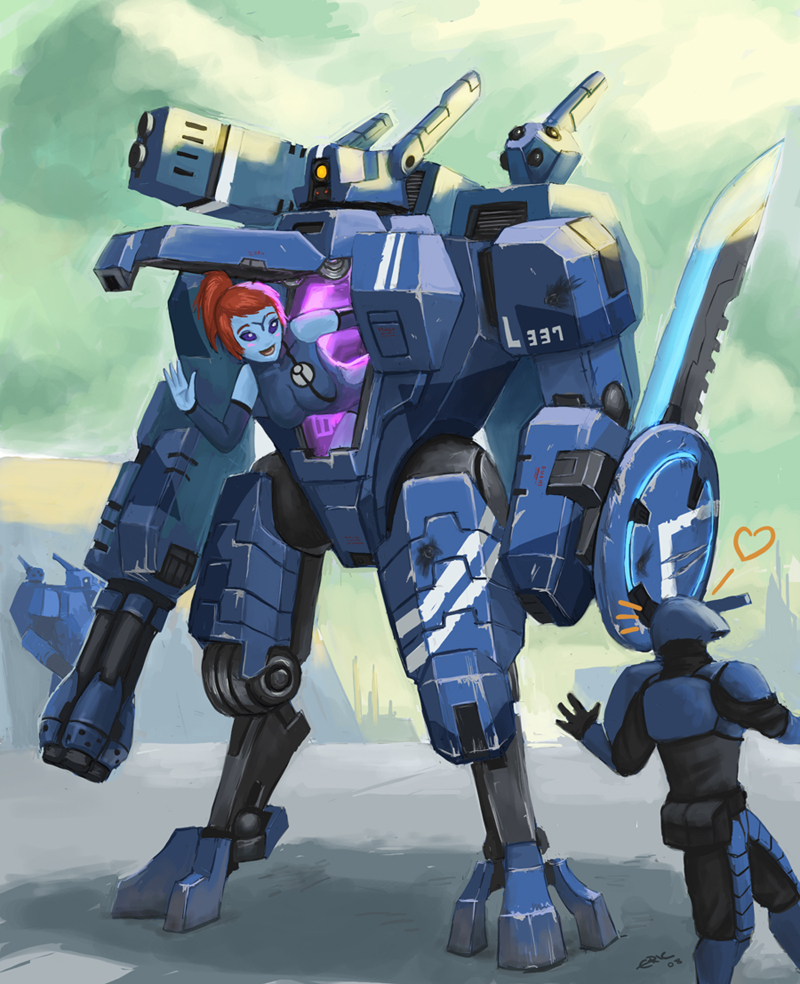My variant is not a cohesive write-up per se. Rather it is an eclectic collection of bolt-ons which work for me.
 |
| Totally stolen off of the internetz |
The basic rules for movement, combat, and damage are unchanged from the base Battletech game. So, these additions make the solo variant suitable for other games.
You will need a deck of playing cards for this variant.
Let us begin...
1. Decide what kind of mission you are going to run. This can be as simple or as complicated as you want. I would recommend simple missions first. This can be a completely narrative goal or just a purely mechanical goal (kill them all!).
2. Set the aggression level for the enemy. This is a value between 2 and 12. The higher the value the less aggressive the enemy is. For an enemy that could go either way set the aggression level to 7. For a timid enemy set the aggression level to a 10 or 11. For a battle-raging enemy set the aggression level to 3 or 4.
3. Set the contact level. This is a value between 2 and 12. This value is used to determine if a sensor reading (blip) is indeed an enemy unit. A contact level set low will generate more enemy units than a high contact level.
4. If you are running a campaign you might want to hash out payment, experience points, and salvage that can be earned for the mission. This step is completely optional.
5. Determine sensor readings (blips). These are markers you will use to represent potential enemy units. I use poker chips. Any kind of token or marker will do. Determine the number of blips by rolling a 1d6.
6. Deploy. The resolution of this part does not really matter. Deploy your units as desired and deploy the blips randomly. For an interesting fight take turns alternating deployment of your units and the blips. The key here is to get the units and blips on the board.
7. Start the game. At the beginning of each turn determine initiative as usual.
8. During the movement phase, when it is time for a blip to move, roll a 1d6 for the direction the blip will travel. Once you know which direction the blip will travel roll a 1d6 to determine how far the blip moves. Move the blip the direction and distance specified. Blips will stop at the board edge. Terrain does not affect the movement of a blip.
After all units and/or blips have moved...time to find out if any of them are bad guys!
Enemy Unit Detection Rules
1. After the Movement Phases but before
the Weapon Attack Phase the player must scan the battlefield, in an attempt to
resolve any blips remaining in play.
2. The player will select one of her
units and a blip (to which she has LOS, terrain rules are in effect for establishing LOS.) and then draw a card from a standard
deck of playing cards.
3. If the card drawn has a numerical
value greater than or equal to the distance of the unit from the blip, the scan
attempt has succeeded. Numbered cards can "see" the number of hexes noted on them. Jacks are 11 hexes. Queens = 12 hexes. Kings are 13 hexes. Aces can "see" 14 hexes. A Joker can discriminate at any range
4. If the card drawn has a numerical
value less than the distance between the two units, the scan attempt
automatically fails.
5. If at this point the scan attempt is
a success the blip has a chance to resist being resolved. A card is drawn for
the blip. If the card drawn has a numerical value equal to or greater than card
already drawn for the detecting unit, the blip succeeds at remaining
unresolved.
6. If the scan attempt is ultimately
successful, then the blip is converted into a unit or removed from the
battlefield.
Important note - If the scanning unit fails to resolve the blip, the blip gets a scan in return to attempt to target the players unit!
The player's unit gets a chance to resist being scanned per the guidelines above.
The player's unit gets a chance to resist being scanned per the guidelines above.
If the blip does get a good scan of the player's unit the blip is immediately converted into an enemy unit OR removed from the board. Follow step 9 resolve the blip.
The now revealed unit may choose to execute a Weapon Attack Phase, and ONLY a Weapon Attack Phase.
9. To convert a blip into an enemy unit roll a 2d6. If the number rolled is equal to or greater than the contact value (2-12) the blip is immediately converted into an enemy unit. Randomly choose an enemy unit put it into the hex the blip occupies.
If the 2d6 roll is less than the contact level, remove the blip from play, it was just a false sensor reading or a sensor spoof.
10. Move onto the weapon attack phase.
11. Shooting and combat phases are carried in initiative order. When an enemy unit is up for shooting they will follow the Enemy Tactic matrix. The enemy unit will fire based off of its stance and heat condition. The enemy units will fire at the closest threat. If two or more units are at equal range, randomly determine which target the enemy unit will engage.
Stance is determined by rolling 2d6 and comparing the result to the aggression level set in step two. If the result is equal to or greater than the aggression level the enemy unit will behave aggressively. If the roll is lower than the aggression level the enemy unit will behave in a passive manner.
OK folks, nearing midnight here. I'll polish this up in the near future.











